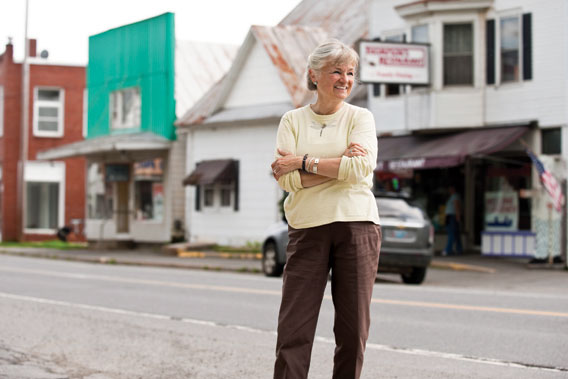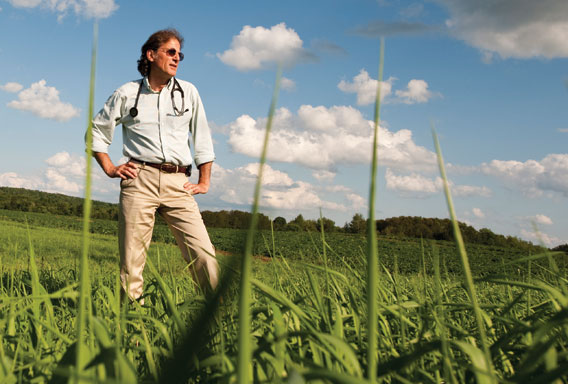Northern Exposure
A bold partnership between Tufts and Maine Medical Center seeks to relieve the doctor shortage in rural areas of the state
By Bruce Morgan
Also:
 Read “The Home Team,” about three students who are on the Maine Track at Tufts School of Medicine.
Read “The Home Team,” about three students who are on the Maine Track at Tufts School of Medicine.
There are really two Maines. The first, consisting roughly of the coastal band that arcs from the New Hampshire border up to Acadia National Park, is well known and beloved by calendar makers, who can’t resist the look of snug harbors filled with sailing craft and lobster buoys heaped in the side yards of the cottages. Once you go 30 or 40 miles inland, or push much farther up the coast, however, all bets are off. You enter an area of small towns, immense fields and deep woods. The state turns poor and bedraggled-looking fast. “As you move away from the southern coast and get north of the I-95 corridor around Bangor, that’s where the challenge is,” confirms Charles Dwyer, director of the state’s Office of Rural Health and Primary Care.

“I’m proud to do good medicine in a small place,” says Cynthia Robertson. Photo: Patrick McNamara
In these more remote areas, there’s a crisis going on. Few young doctors are electing to practice medicine in small-town Maine, and the consequences of this trend are dire for the people who live there.
Doctors tend to be more concentrated in cities than in rural areas. While this is a national demographic truth, Maine is harder hit than most places. According to a comprehensive report released by Dwyer’s office in 2008, only five other states in the U.S. have a higher percentage of people living in non-metropolitan areas—an index known as a state’s degree of “rurality.” The report found that Maine’s rural residents are older, poorer, sicker and less educated than its more-urban dwellers. They are more likely to be unemployed. They suffer disproportionately from chronic illness and substance abuse. In medical terms, rural residents are hanging by a thread. And just 39 percent of them have a personal doctor.
In Maine, as elsewhere, doctors are getting older and retiring. The trouble is that their numbers are not being replenished. As director of the Maine Hospital Association, which tracks physician openings around the state, Jane Ham knows this better than anyone. (Few doctors in Maine are not affiliated with a hospital.) “It’s a worsening situation,” she states. “When we started our recruitment center a decade ago, we had 91 openings. A year or so ago, we had 206. Now we’ve got 272 physician openings, of which 121 are in primary care—the backbone of health-care delivery in Maine.”
Late this summer, in partnership with Maine Medical Center, Tufts School of Medicine launched an innovative program aimed at alleviating the physician shortage in rural and small-town Maine. Called the Maine Track, the program enrolled 36 students who have shown promise for establishing practices in the state. Of these, 20 slots were reserved for Maine natives or applicants with close ties to the state. Half-tuition scholarships were offered to these students as an added enticement. (See a related story.)
Click the play button to hear two Maine students at Tufts School of Medicine talk about their experiences in the Maine Track program. Video by Kaitlin Provencher
Maine Track students will spend their first two years in Boston before shifting to the 600-bed Portland hospital for their third-year clerkships and part of their fourth-year rotations. Extended, multi-month clerkships will ultimately be offered at a half-dozen sites around the state so that students can immerse themselves in community-based medicine on an intimate scale.
Give the kids a whiff of pine and hope they like it and decide to stay—that’s the gist of the idea. “It’s all about quality of life,” Jane Ham points out. “We always tell doctors they can have a good clinical practice here, plus be able to spend time with their family.”
And what if the prospective docs enrolled in the Maine Track sample the country life and decide they don’t like it? “Well, at least they’ve had some exposure,” Ham responds, laughing. “Rural life is not for everybody. But right now they’re not getting any exposure at all.” Maine has no allopathic medical school of its own, exacerbating the doctor-supply problem.
What is it like to practice medicine in rural Maine? In late June, I set out to answer the question. I visited three Tufts medical school graduates who have served three distinctly different geographic regions of the state—woods, northern coast and potato field—for a collective total of 85 years. I figured if these people didn’t know, no one would.
Bingham: Nothing Else for Miles
The town of Bingham, Maine, has seen better days. From its weather-beaten main street, with its handful of boarded-up storefronts beside the surging Kennebec River, to its lone, usually vacant motel, this town of fewer than a thousand people looks like it’s been whacked hard and is still reeling from the blow. Lumber trucks hurtle along the main drag, sometimes empty, sometimes full. Ten miles north of here, you are into some serious woods. Bingham residents have few employment options, either working in the woods, or seasonally for one of the river-rafting companies, or over at the nursing home.
“It’s a town in decline,” says resident Myron Morris, 82, bluntly. “The mill went away, and the logging industry has gone downhill.” Morris moved to town in 1950 and once owned a trucking company. Now he’s seated in the lobby of the Bingham Area Health Center, a modern one-story building in the middle of town, waiting for his regular check-up.
Cynthia Robertson, M80, sweeps into the waiting room. Petite and dynamic, with frosted hair and a quick smile, she is perfectly cast for the role of the briskly efficient, small-town doc. Robertson signed up with the National Health Service Corps, which gives financial incentives for service in rural America, after graduation.
In a way she was echoing her father, who had been a small-town physician in upstate New York. “The main thing I saw in him was a contentment in his life,” she says. Robertson did her residency in Augusta and has been Bingham’s chief physician for the past 26 years.
The clinic serves as an all-purpose health center for the town, since there’s nothing else for miles around. A dentist stops by several days a week to examine Bingham’s teeth—and there are ambitious plans to expand the service. Two therapists are available part-time for mental health counseling. During the summer months, there’s even a high school guidance counselor who’s ready to advise kids one day a week in an office down the hall.
The clinic has made itself a trusted neighbor. “When you’re a country doc, you’re sort of responsible for the health of that community,” says Robertson, who has served as medical director of the town nursing home and worked in a nearby hospice. She still makes house calls two or three times a month.
Forging a close relationship with patients is a key concern in rural areas, and absolutely essential to cultivating good health, the doctors interviewed for this story agree. Your life is transparent. There’s no place to hide. You live or die by what people think of you.
Robertson says the Bingham clinic’s central location and its staffing with town residents reflects that focus. “All the people who work here are familiar faces,” she points out. “People trust us, and therefore they bring their problems a little sooner, and they don’t get so sick. We keep them out of the ER, out of the hospital, and in that way we’re really cost-effective.”
Machias: Laughter in the House

“I was never able to let go of trying to take care of patients the best I could,” says Christopher Mace. Photo: Patrick McNamara
If you drive up the Maine coast about 50 or 60 miles farther than tourists usually do, into Washington County, the people start to be outnumbered by lobster boats. The land is windswept and rocky, and the towns are scattered and few. Nobody makes much money; this is about as close to the bone as life in Maine gets. With slightly more than 1,000 residents, Machias is something like the capital of this northern stretch of coast. Christopher Mace, M68, grew up in this community, where his dad ran a lumber mill.
After graduation from medical school, residency in Washington, D.C., and the beginning of military service in Vietnam, Mace was recruited back home by U.S. Sen. Margaret Chase Smith to provide desperately needed medical care to the region. He ended up being one of the rare doctors in the vicinity, first working for three years at a clinic in Gouldsboro and then carrying on his practice back in Machias for a longer stretch. Mace retired in 2005.
In practice in his hometown, Mace found that everything was personal. The handshake, the smile, the nod to a neighbor was another brand of cure. The sense of responsibility also felt intensely personal. “As a doctor, you’re part of a community where you have a certain standing,” he says. “The major rewards of that involved dealing with patients who were grateful.” Every holiday season, townspeople would show up at the doctor’s door bearing homemade cakes and cookies in tribute to his devotion.
Often the doctor’s healing came down to an old-fashioned laying-on of hands or the deft application of a soothing voice. Mace had a home office in those days. His wife, Suzanne, recalls how she would often see a patient trudging into the house with some unknown complaint or other. “And then I’d hear this laughter,” she marvels. “The patient would come out saying, ‘I don’t know what he does, but I feel so much better.’ ”
Mace wore his stethoscope for 30 years. Realizing that he would otherwise be swamped by the ever-increasing paperwork that went with medicine, Mace signed on with a hospital in town for the final lap of his career. But he continued to make house calls right up until the end. “I was never able to let go of trying to take care of patients the best I could,” he says quietly.
Houlton: A Residue of Wind and Cold
Angling north of Bangor on I-95, the land peels back and flattens its line, growing stupendous in scale. Welcome to Aroostook County, the largest county east of the Mississippi River—it’s about the size of Connecticut and Rhode Island combined—and one of the emptiest, with only 11 folks per square mile. This is a part of Maine where a town of 5,000 people manages to be the biggest deal around.

“Rural practice is the best medicine there is,” says Ted Sussman. “Unfortunately, we physicians are a dying breed and can’t replace ourselves.” Photo: Patrick McNamara
Ted Sussman, M77, has been a doctor in Houlton since 1980. He and his wife have raised three sons here, and although he doesn’t hunt or fish, he has a boat on a nearby lake and savors the life available to him. “Rural practice is the best medicine there is,” he says. “Unfortunately, we physicians are a dying breed and can’t replace ourselves.” Sussman loves his mostly elderly patients, many of whom he has known for many years, and if a morning’s sample is any indication, they love him right back.
Sussman’s office is at Houlton Regional Hospital, a modern 50-bed facility that resembles the anchor store in a suburban shopping mall and draws patients from a 45-mile radius. The doctor’s pace as he moves through the halls is not the easy country stroll you might expect. Instead, he strides between the rooms where the patients wait, swinging through each doorway in turn and, once inside, slowing the speed of his delivery to consult with them. Sussman grew up near New York City, and you can see it in the hall.
Ed, the first patient, is 75 years old and drives a truck for work. He is wearing jeans and heavy boots. Ed has been coming to Sussman for 20 years now and reports, with typical Maine understatement, “He’s a pretty good doctor, I think.” Ed has been taking medicine for a heart condition. Sussman tells him that his pulse rate is still too high and that he’d like to adjust his medication to slow it down a bit. “That’s what I’m scared of,” Ed replies, studying the doctor’s face. Sussman gives a careful explanation of the move. “Don’t give me too many big words—give me truck-driving words,” Ed jokes, but it’s clear he is reassured by what he’s hearing.
Sussman carries a full patient load here at the hospital, seeing 20 or 25 patients a day, and is perpetually on call. Lynn York, proprietor of York’s Bookstore in the compact business district of Houlton, knows Sussman well as the man who tended his father through multiple surgeries during the final stage of his life (“He kept my father alive for 20 years,” he says feelingly) and as someone available to his patients around the clock. “I’ve been with him at movies over there many times,” York relates, pointing directly across the street to the movie theater marquee, “and his beeper would always go off. I doubt he ever saw a whole movie.”
Roy, today’s second patient, is neatly dressed in a cream-colored checked shirt and dark slacks. His combed hair is pure white. Roy tells the doctor, seated in front of him, that he has been feeling cramps in his right leg whenever he walks any distance. “Gettin’ so you can’t be 80 years old without going to hell just like that,” he exclaims, looking around the room with a giant smile. Patients in Houlton are a good-hearted and cheerful bunch. No matter what hits them, it seems, they’ve seen worse.
Sussman worries about the prospects for patients like Roy in the days to come. There was a surge of young doctors into rural areas after the National Health Service Corps came along in 1970, a time coincident with the first sizable crop of women to enter the medical profession. “Most docs came up here in the 1970s. There’s a generation about to retire,” he points out. “Our ability to replace them is, right now, zero.”
That’s a sobering charge. If Sussman is correct, the challenge facing the graduates of the Maine Track is twofold—first to buck stubborn historic trends by setting up shop in isolated places like Bingham, Machias and Houlton, and then to summon from somewhere deep inside the essence of doctoring. With its rugged landscape, its poverty and its charm, rural Maine awaits the resolution.
A longer version of this story first appeared in the fall 2009 issue of Tufts Medicine magazine.
Bruce Morgan can be reached at bruce.morgan@tufts.edu.

